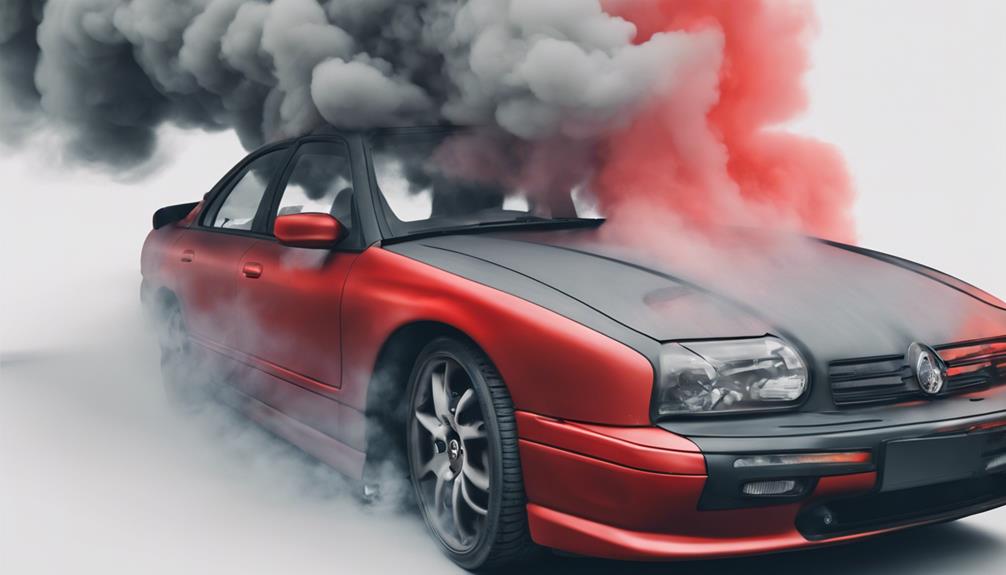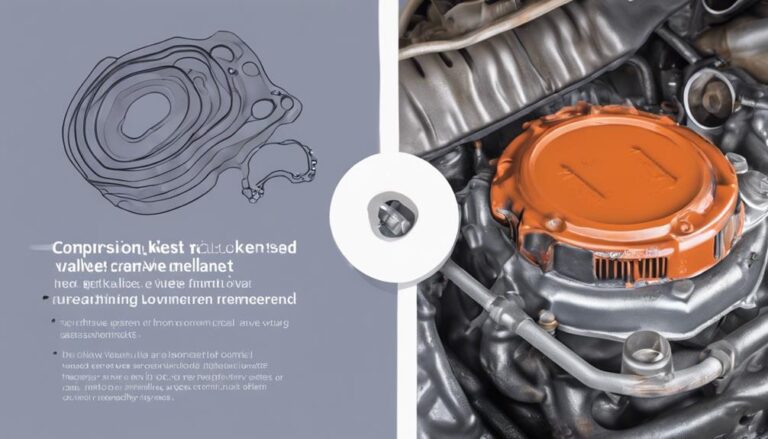Identifying Signs of a Faulty Head Gasket
Did you know that a faulty head gasket is one of the leading causes of engine failure, accounting for up to 75% of catastrophic breakdowns? Engine overheating, white smoke from the exhaust, coolant leaks, milky oil, and loss of power are all common signs of a faulty head gasket.
But what other subtle indicators should you be aware of to catch this issue before it escalates? Let's explore some lesser-known symptoms that could save you from costly repairs down the line.
Key Takeaways
- Engine overheating, white smoke, coolant leaks, milky oil, and power loss signal potential head gasket issues.
- Address overheating promptly to prevent engine damage from coolant mixing with oil.
- White smoke from exhaust, accompanied by a sweet smell, indicates possible coolant-fuel mixing.
- Loss of power, misfires, and reduced acceleration may point to a faulty head gasket affecting engine performance.
Engine Overheating

If your engine is consistently overheating, it may be a sign of a faulty head gasket. The head gasket plays an essential role in maintaining the integrity of the combustion chamber and the cooling system. When the head gasket fails, it can lead to the mixing of coolant and engine oil, causing the engine to overheat.
One common consequence of a faulty head gasket is radiator issues. The head gasket seals the combustion chambers, preventing the mixing of engine oil and coolant. If the head gasket is compromised, coolant can leak into the combustion chamber or mix with engine oil. This can result in a decrease in the effectiveness of the cooling system and lead to overheating.
To prevent further damage to your engine, it's essential to address any signs of engine overheating promptly. Checking for symptoms of a faulty head gasket, such as radiator issues, can help you identify and resolve the problem before it escalates. Regular maintenance and timely repairs are key to ensuring the proper functioning of your vehicle's cooling system.
White Smoke From Exhaust
When observing white smoke emanating from your exhaust, it can indicate a potential issue with your vehicle's engine, particularly related to the combustion process. White smoke is often a sign of faulty combustion within the engine, where coolant or water is being burned along with the fuel. This can point towards a leak in the head gasket, allowing coolant to seep into the combustion chamber and mix with the fuel, causing the white smoke to be expelled through the exhaust system.
It is important to address white smoke from your exhaust promptly as continued driving in this condition can lead to further damage to your engine components. The presence of white smoke may also be accompanied by a sweet smell from the exhaust, which is a distinct characteristic of burning coolant. To accurately diagnose and resolve this issue, it's recommended to have your vehicle inspected by a qualified mechanic who can assess the health of your engine and exhaust system thoroughly.
Coolant Leaks

In diagnosing potential issues with your vehicle related to the head gasket, identifying coolant leaks is an important step in maintaining the health of your engine. Coolant leaks can be indicative of a faulty head gasket, leading to a mixture of coolant and oil, which can severely damage the engine if left unattended.
When dealing with coolant leaks, it's vital to address them promptly to prevent further damage and costly repairs.
To prevent coolant leaks, regular maintenance is key. Check for any signs of corrosion around the cooling system components, as corrosion can weaken the gasket and lead to leaks. Additionally, consider using sealant options specifically designed to address minor leaks and prevent future ones. These sealants can provide a temporary fix while you arrange for a more permanent solution.
Milky Oil
Identifying milky oil in your vehicle can indicate a significant issue with the head gasket, potentially leading to severe engine damage if left unaddressed. This phenomenon occurs due to oil contamination by the cooling system, suggesting a breach that requires immediate attention. Here's what to look for:
- Visual Inspection: Check the oil dipstick or oil cap for a milky or frothy appearance.
- Coolant Analysis: Test the coolant for traces of oil; this could indicate a leak into the cooling system.
- Oil Quality: Monitor oil quality; a milky texture or color change suggests contamination.
- Professional Diagnosis: Seek a mechanic's assessment to confirm head gasket issues accurately.
Milky oil is a clear sign of potential head gasket failure, emphasizing the critical role of regular vehicle maintenance. Addressing this promptly can prevent costly engine repairs and safeguard your vehicle's longevity.
Loss of Power

To diagnose potential head gasket issues, pay attention to any noticeable loss of power in your vehicle. One of the key indicators of a faulty head gasket is a decrease in engine performance, leading to decreased acceleration and engine misfires. If you experience a significant loss of power while driving, it could be a sign that combustion gases are escaping past the head gasket, causing a disruption in the engine's functionality.
| Signs of a Faulty Head Gasket | |
|---|---|
| 1. Loss of Power | � |
| 2. Milky Oil | � |
| 3. Overheating | � |
| 4. White Smoke from Exhaust | � |
| 5. Coolant Leaks | � |
If you notice your vehicle struggling to accelerate or experiencing frequent engine misfires, it is essential to have your head gasket inspected by a professional mechanic. Ignoring these warning signs can lead to more severe engine damage and costly repairs down the road. Remember, addressing issues promptly can help maintain the health and performance of your vehicle.
Frequently Asked Questions
Can a Faulty Head Gasket Cause My Engine to Misfire?
A faulty head gasket can indeed cause your engine to misfire. This issue impacts engine performance, leading to irregular combustion in the cylinders. Watch out for symptoms like rough idling, loss of power, and white smoke from the exhaust.
How Can I Tell if My Head Gasket Is Leaking Externally or Internally?
When checking for external leaks, watch for your engine's sweat, like a fevered brow. If overheating persists, suspect a thirsty gasket. Internally, a coolant vanishing act signals leaks within. Keep tabs on your engine's secret habits.
Is It Possible for a Damaged Head Gasket to Cause My Car to Emit Strange Smells?
If you notice unusual odors coming from your car, a damaged head gasket could be the culprit. Performance issues, such as overheating, can also point to this problem. It's vital to address these signs promptly to prevent further damage.
Can a Faulty Head Gasket Lead to Issues With My Car's Air Conditioning System?
When a faulty head gasket messes with your car's cooling system, it can sneakily lead to air conditioning woes. Refrigerant leaks may start haunting your vehicle, making that cool breeze vanish into thin air.
Are There Any Specific Warning Signs of a Faulty Head Gasket That I Should Look Out for During Cold Weather Conditions?
During cold weather, be vigilant for potential head gasket issues. Regular maintenance and proper care can help prevent costly repairs. Stay alert to warning signs like coolant leaks, overheating, or white smoke from the exhaust.
Conclusion
To summarize, identifying signs of a faulty head gasket is vital in preventing costly engine damage. Engine overheating, white smoke from the exhaust, coolant leaks, milky oil, and loss of power are key indicators to watch out for.
By recognizing these symptoms early on, you can address the issue promptly and avoid further complications. Remember, staying vigilant and proactive in maintaining your vehicle can save you time and money in the long run.
Stay alert, and keep your engine running smoothly.







